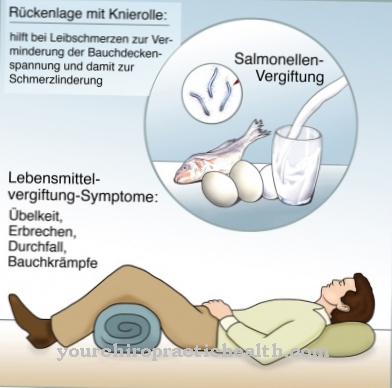As Acute scrotum is sudden and severe pain in the testicle area. These can also be accompanied by swelling. Various diseases are possible causes of an acute scrotum.
What is an Acute Scrotum?
The technical name for the scrotum is scrotum. Accordingly, the term "acute scrotum" summarizes various clinical pictures that are associated with acute pain in the scrotum.
An acute scrotum is an emergency that always requires a urological evaluation. The causes of the acute scrotum are diverse. Inflammations, trauma, tumors or congenital malformations are possible.
causes

Acute scrotum is sudden and intense pain in the testicle area. These can also be accompanied by swelling.
An acute scrotum can be caused by various diseases. One cause is inflammation of the testicle. Both the testicle itself (orchitis) and the epididymis can be inflamed. An inflammation of the epididymis is called epididymitis. Orchitis is a dreaded complication of mumps infections. Inflammation of the spermatic ducts (deferentitis) and the spermatic cords (funiculitis) can also result in an acute scrotum.
The scrotal skin, i.e. the skin of the scrotum, can also become inflamed. If this inflammation leads to a scrotal abscess, i.e. to an accumulation of pus in the tissue of the scrotum, this can result in an acute scrotum. An inflammation of the scrotum caused by ß-hemolytic group A streptococci is called erysipelas. The erysipelas of the scrotum is very painful and therefore often the cause of an acute scrotum.
The term testicular torsion is understood to mean the partial or complete rotation of the testicle around the vascular pedicle, through which the vessels that supply the testicles run. Testicular torsion always manifests itself in the form of an acute scrotum. The same applies to the so-called hydrate torsion. This is a twisting of the testicular or epididymal appendages. Testicular torsion and hydatid torsion are usually preceded by a developmental anomaly.
Often the clinical picture develops at night. However, minor trauma or physical activity such as sport or exuberant play in children can also be triggers. Other causes of an acute scrotum are insect bites, acute lymphatic congestion or scrotal edema. Lymph congestion is often the result of surgery on the scrotum or is associated with cancer of the testicles or prostate. Scrotal edema, i.e. water retention in the scrotum, can occur as a result of allergies or idiopathically, which means without any recognizable cause.
You can find your medication here
➔ Medicines for painSymptoms, ailments & signs
Cardinal symptom of acute scrotum is severe pain in the scrotum. This can occur very suddenly or it can increase slowly. In most cases, only one testicular compartment is affected. An acute scrotum with involvement of both testicular compartments is rather rare. The pain is very intense and typically radiates into the groin region. In addition, in most cases the scrotum is very red and the skin of the scrotum is overheated. The affected side of the scrotum may be swollen.
Diagnosis & course
An acute scrotum is always a urological emergency. In particular, if a testicular torsion is suspected, action must be taken quickly. Six to eight hours after the torsion, the tissue of the testicle becomes necrotic, which means that it dies and can then no longer be saved. In newborns, the time to necrosis is even shorter. The result is the loss of one or even both testicles.
An extreme pressure sensitivity of the testicle speaks in favor of testicular torsion. The Prehn's sign is used as a urological examination method to differentiate the acute scrotum. The doctor lifts the patient's affected testicle. During this time, the patient should lie as relaxed as possible on the examination table.
If the pain increases or remains the same when lifting the testicle, the Prehn's sign is negative.A negative Prehn sign suggests testicular torsion. If the pain decreases when the testicle is lifted, the Prehn's sign is positive. A positive Prehn's sign indicates inflammation of the testicles or epididymis.
The Prehn's sign is suitable for getting an initial indication of a possible cause in the case of an acute scrotum. However, this examination is not particularly reliable, so further diagnostic measures must be taken. The so-called cremaster reflex also provides possible indications of testicular torsion. In the case of the cremaster reflex, stroking the inside of the thigh triggers an uplift of the testicle on the same side.
If this does not lift, testicular torsion may be present. If a torsion is suspected, color Doppler sonography is usually performed immediately in the clinic or doctor's office. This shows either reduced or normal to increased blood flow. Sonography can also diagnose the other causes of acute scrotum. One hundred percent diagnostic certainty in suspected testicular torsion is only given by surgical exposure of the testicle.
Complications
An acute scrotum can cause a variety of complications. Initially, the inflammation can spread to the testicles and epididymis, accompanied by severe pain and pressure in the area of the scrotum. When touched, the symptoms are usually increased considerably and accompanied by nausea and fever symptoms.
In the further course there is a risk of compression of the testicle or thrombosis; In severe cases, both can lead to a testicular infarction and ultimately to death of the testicle. In rare cases, an acute scrotum can lead to the compartment syndrome with severe scrotum pain, feelings of tension and sensory disorders such as tingling and numbness. The development of chronic epididymitis is also a risk.
If a serious, possibly chronic, secondary disease develops from the acute scrotum, this can lead to infertility and other, similarly serious complications. Fertility is usually also reduced after an acute scrotum. If the symptoms are treated early, however, serious complications can almost always be avoided. However, there are risks involved in the treatment itself: allergic reactions to drugs, painful scrotal abscesses and the formation of fistulas after surgery.
When should you go to the doctor?
In the case of an acute scrotum, a doctor should always be consulted. Although the cause of the swelling may not be serious, an examination should always be done. In this way, irreversible consequential damage can be avoided. As a rule, a doctor should be consulted if there is severe pain and swelling. Above all, violent and stabbing pains occur, which can often spread to other regions of the body.
If a so-called testicular torsion has occurred, a doctor must be consulted immediately. Here, however, the patient can also contact a hospital or call an ambulance. The earlier treatment is started, the lower the risk of various consequential damages and potency restrictions.
Medical treatment is also necessary in the case of numbness in the region of the soft tissues and testicles. If no treatment occurs, infertility will occur in many cases. This is usually irreversible and can lead to severe psychological complaints and significantly reduce the patient's quality of life.
Doctors & therapists in your area
Treatment & Therapy
Treatment of the acute scrotum depends on the cause. While surgery cannot be avoided in testicular torsion, symptoms of hydatid torsion usually resolve spontaneously within a few days and then disappear. Inflammation of the testicles and epididymis requires drug therapy with antibiotics.
Bed rest, elevation and cooling of the testicle are also indicated. Inflammation of the vas deferens or spermatic cords are usually treated with antibiotics. The treatment of lymphedema of the scrotum by means of manual lymphatic drainage is often tedious and not always promising.
Outlook & forecast
In most cases, acute scrotum patients experience very severe pain in the testicles. This pain is extremely uncomfortable for men and can spread to other regions of the body and lead to discomfort there as well.
As a rule, the further course of this disease depends heavily on the cause of the acute scrotum. Most of the time, the pain also radiates to the groin region. There is also a strong warming of the scrotum. If this warming persists over a longer period of time, it can lead to impotence and thus to the inability to conceive.
It is not uncommon for this to lead to psychological complaints or even depression. Furthermore, there is also a strong swelling of the scrotum. The testicles themselves can feel numb or, in the worst case, even die. This is especially the case with so-called testicular torsion.
Treatment of the acute scrotum is usually causal and symptomatic. The symptoms can be alleviated with the help of pain relievers. Antibiotics are used for inflammation. In most cases the disease progresses positively.
You can find your medication here
➔ Medicines for painprevention
An acute scrotum cannot usually be prevented. It is important to consult a doctor immediately in the event of severe pain in the testicular area so that testicular torsion can be excluded as the cause of the acute scrotum.
Aftercare
An acute scrotum is severe pain in the testicle area. Thus, it is not an independent disease, but rather a symptom of an independent disease. In most cases, such acute scrotum is due to inflammation of the testicles, which can be effectively relieved by appropriate medication.
Subsequent follow-up care is very important and significant after the illness has been overcome in order to recognize and treat a renewed germination of the inflammation at an early stage. If the person concerned decides to have medical or medical follow-up care, then the course of the disease can be expected to be free of complications. If the inflammation of the testicles has subsided, further visits to the doctor should be made.
Only careful follow-up care can reveal a renewed inflammation of the testicles at an early stage and prompt treatment. If the affected person decides against such aftercare, serious complications can be expected. Under certain circumstances, the inflammation can spread throughout the body, so that there is even a risk of blood poisoning. An acute scrotum always requires professional and appropriate follow-up care. This allows unnecessary and serious complications to be avoided from scratch. The formation of a new scrotum is nipped in the bud with follow-up care.
You can do that yourself
The acute scrotum is always an emergency situation that requires medical treatment. Depending on its cause, the acute pain can be relieved with some self-help measures and home remedies.
If the acute scrotum is based on testicular torsion or contusion, the scrotum should be immobilized. The scrotum must not be moved to avoid further pain attacks and twisting of the testicle. In addition, the person concerned should be calmed down and, if possible, distracted from the intense pain.
At the same time, cold packs or cold compresses can be applied as first aid measures. Medicinal plants such as nettle, valerian or lavender, which are either drunk or applied in the form of ointments, are also useful for pain relief. These measures should always be done in consultation with a doctor to avoid complications.
After the acute pain has been relieved, you should go to the hospital for further evaluation. Sometimes it is necessary to treat the inflammation medically or to surgically return the testicles to their original position. In addition, the trigger for the acute scrotum must be determined. The doctor can then suggest further measures for acute pain relief and give tips on prevention.

.jpg)











.jpg)

.jpg)
.jpg)











.jpg)